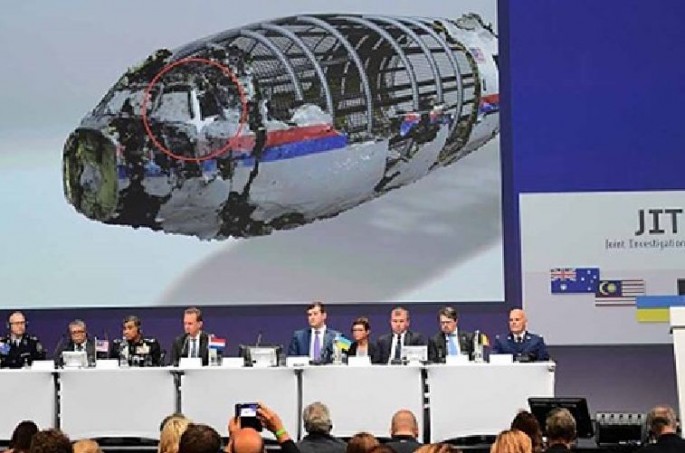A single Russian army surface-to-air missile on a launcher that traveled from Russia into Ukraine and back again was responsible for destroying Malaysia Airlines Flight 17 (MH17) on July 17, 2014 killing 298 innocent civilians.
A Joint Investigation Team (JIT) consisting of investigators from five countries spent two years painstakingly piecing together an incredible mass of evidence that conclusively proves a surface-to-air missile (SAM) from a BUK missile system of the Russian army was deliberately driven into eastern Ukraine for the express purpose of shooting down Flight MH17.
Criminal investigators said they have solid evidence the Malaysian jet was shot down by a BUK missile moved into eastern Ukraine from Russia. The jet was downed by a single SAM from the rebel-controlled village of Pervomaysk.
Wilbert Paulissen, head of the Central Crime Investigation department of the Dutch National Police, said intercepted communications showed pro-Russia rebels called for deployment of BUK and reported its arrival in rebel-controlled areas of eastern Ukraine.
From that and other evidence, "it may be concluded MH17 was shot down by a 9M38 missile launched by a BUK, brought in from the territory of the Russian Federation, and that after launch was subsequently returned to the Russian Federation," said Paulissen at a news conference.
Prosecutors can't file charges but victims' relatives have been seeking details of who shot the plane down hoping it might lead eventually to prosecutions of the Russians and Ukrainian rebels responsible. The investigative team said it has identified 100 people described as being of interest to them.
The evidence includes intercepted wireless conversations between the Russian crew of the BUK launcher and their comrades that directed them to the launch site; video and pictures of the three vehicle convoy that traveled from Russia taken by persons along the streets traversed by the convoy; interviews with hundreds of persons and an actual detonation of the warhead of a BUK missile to identify its characteristics.
Taken together, the massive amount of evidence left no doubt a Russian army missile system manned by Russian army soldiers deliberately took aim at and shot down MH17 from territory controlled by rebels loyal to Russia.
Russia, of course, denied the conclusive findings putting forward another fantastic excuse to support its lie. It claims to now have in its possession new radar data showing the missile could not have been fired inside territory held by rebels sympathetic to it. Why that radar data wasn't presented in 2014 isn't clear, however.
During the early months of the investigation into the destruction of MH17, Russia claimed a Ukrainian jet shot down the airliner.
Russia even produced a photograph showing the alleged Ukrainian fighter closing in on MH17. That lie was exposed for what it was when experts determined the proportions of the alleged fighter and MH17, a Boeing 777-200ER airliner, were unrealistic.
The alleged Ukrainian fighter would have had to have been the size of an aircraft carrier if the Russian photo was accurate. The Russians then withdrew the claim.
Dutch police and judicial officials worked with counterparts from Australia, Belgium, Malaysia and Ukraine in the JIT, gathering the best possible evidence for use in prosecution of the perpetrators.
Eleven containers filled with debris from the jetliner was taken to the Netherlands. A research team took soil samples in eastern Ukraine and established the location of cellphone towers and the layout of the local telephone network.
BUK (the Russian word for beech) is a mobile missile system made only by Russia. The system consists of six vehicles: a target acquisition radar vehicle; a command vehicle; radar vehicles and three transporter erector launcher vehicles that carry the missiles.
There are two versions of the BUK missile system: the older SA-11 (NATO reporting name, Gadfly) and the newer SA-17 (NATO reporting name, Grizzly). That the warhead was an 9N314M means it could have only come from a 9M38 series SAM that arms the SA-11 Gadfly.
The 9M38 missile is 5.55 meters long, weighs 690 kilograms and carries a massive 70 kilogram warhead triggered by a radar proximity fuze that detonates a short distance from its target.
This missile series has only two models: the 9M38M introduced in 1979 with a range of 46,000 feet and the newer 9M38M1 introduced in 1984 with a range of 72,000 feet.
Both models are armed with the 9N314M fragmentation warhead that hurls some 7,600 oddly shaped pre-formed fragments or pieces of shrapnel into a target aircraft. These types of pre-formed fragments are only carried by the 9N314M warhead arming a 9M38-type missile.
Because hundreds of bow-tie shaped fragments were found in the bodies of the three crewmen on the flight deck and embedded in other parts of the aircraft, it's certain a 9M38 missile was responsible for the shoot down. The shoot down was achieved at an altitude of 33,000 feet.



























